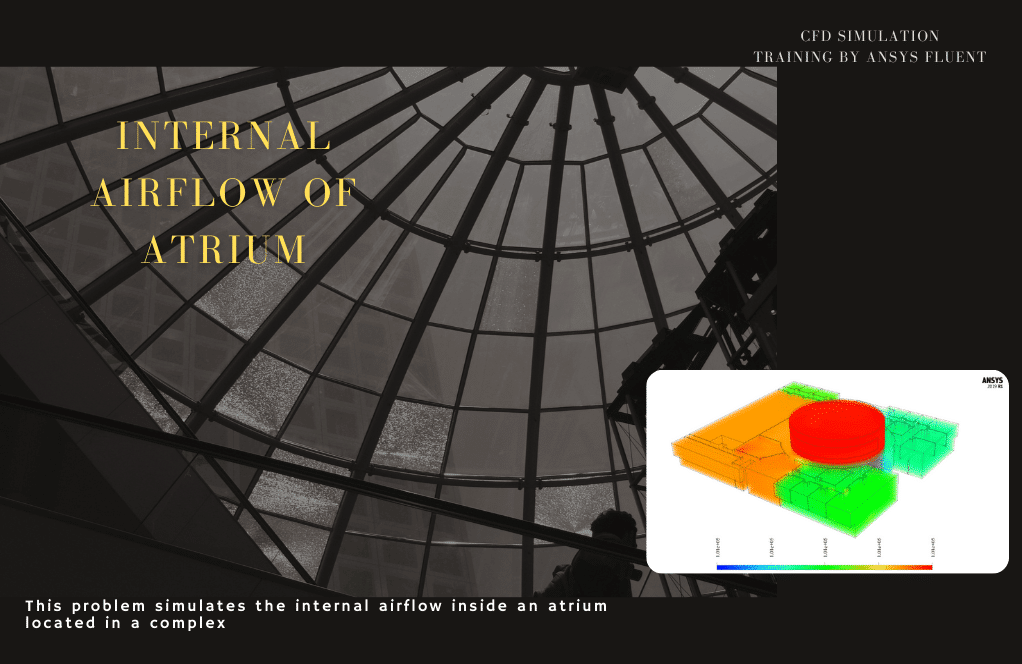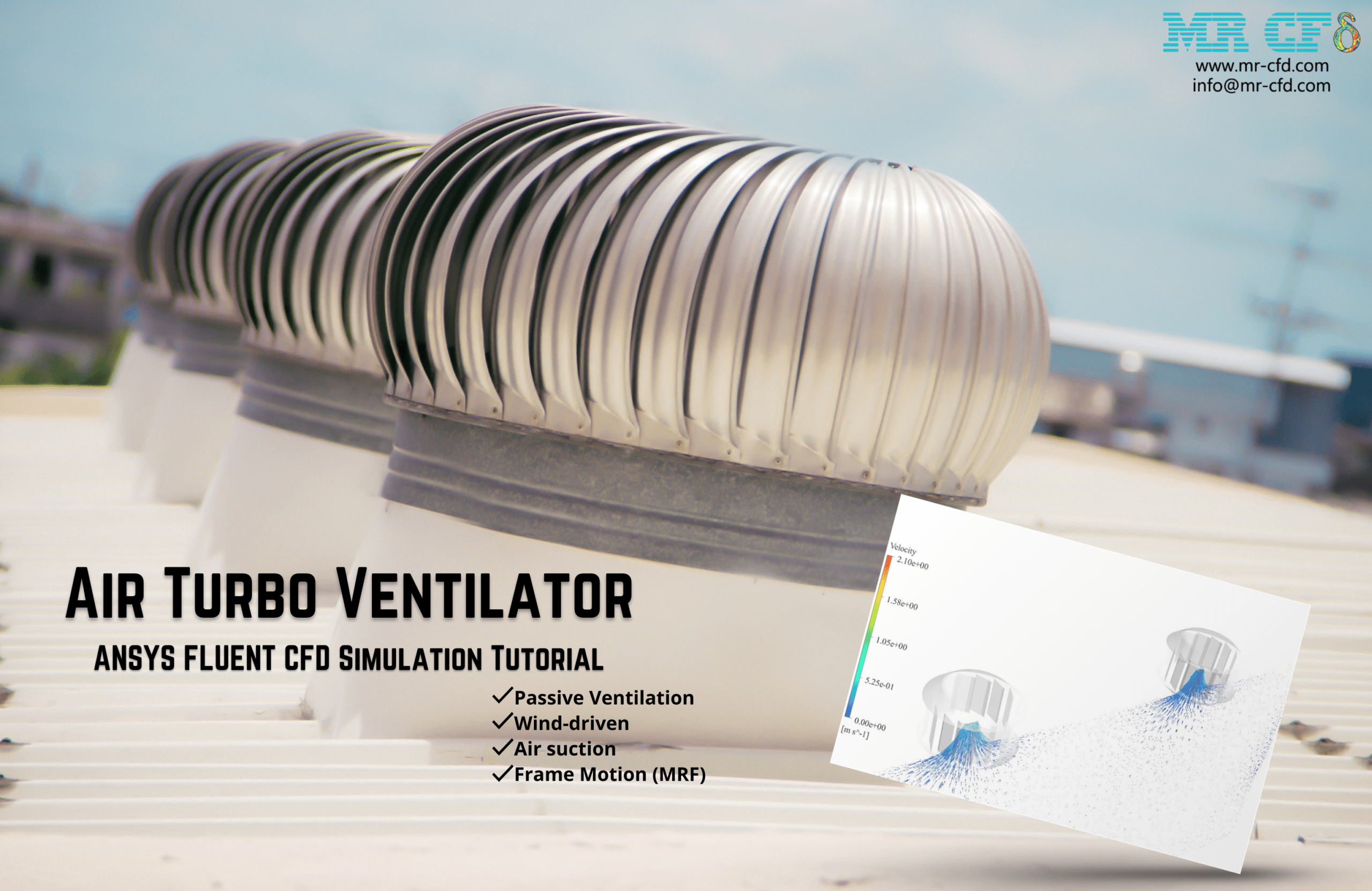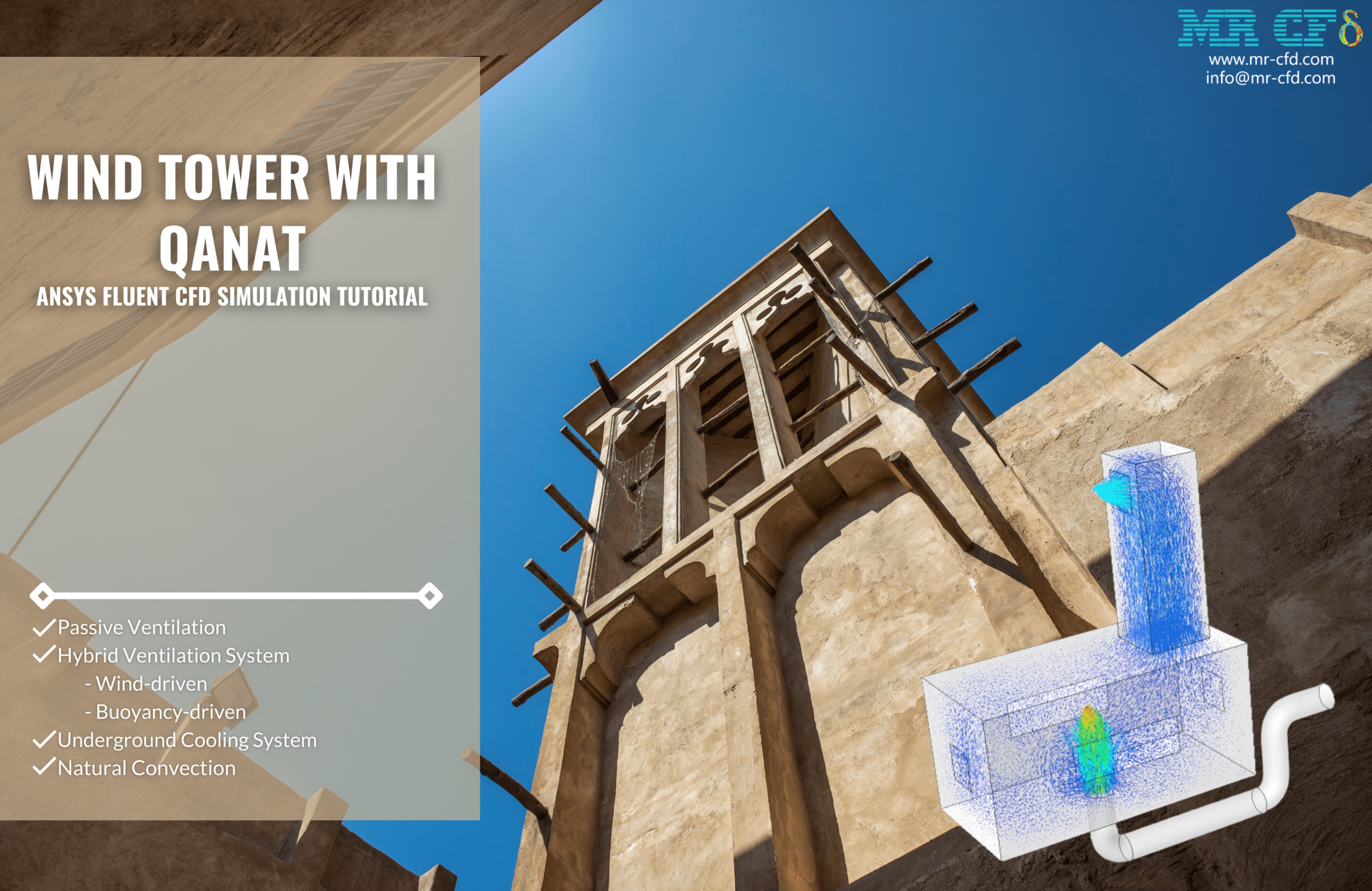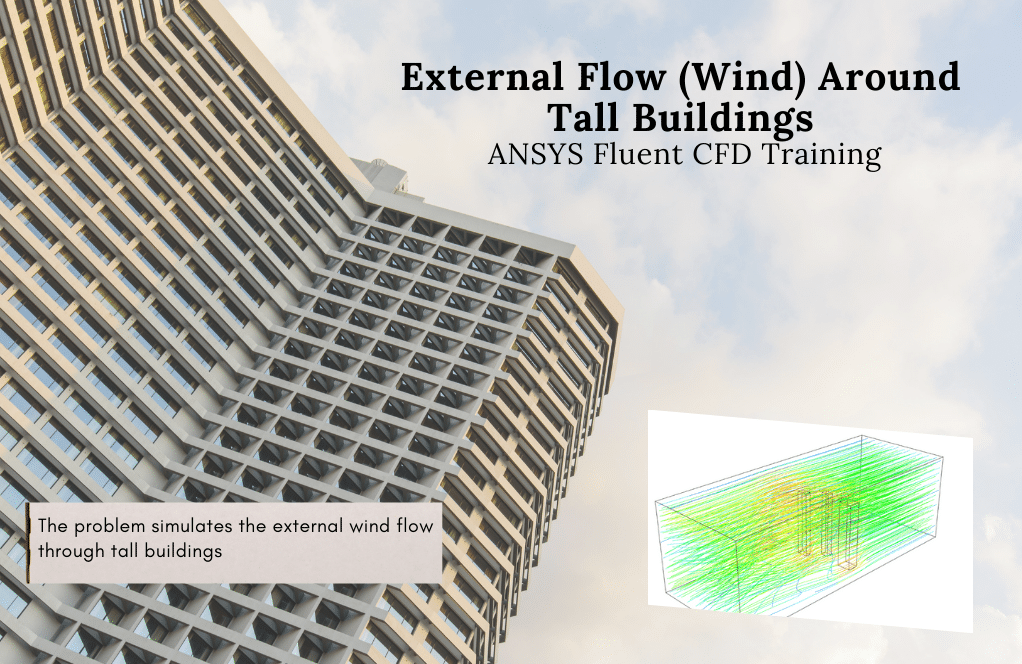Passive Ventilation CFD Simulation Training Package, 10 Projects by ANSYS Fluent
$159.00 $79.50 Student Discount
In this CFD simulation training package, we have studied various methods for different Passive Ventilation systems. There are 10 CFD projects, including a windcatcher, atrium, turbo ventilator, solar chimney, facade, balcony, wind tower, PCM application, and wind tower with qanat.
Click on Add To Cart and obtain the Geometry file, Mesh file, and a Comprehensive ANSYS Fluent Training Video.To Order Your Project or benefit from a CFD consultation, contact our experts via email (info@mr-cfd.com), online support tab, or WhatsApp at +44 7443 197273.
There are some Free Products to check our service quality.
If you want the training video in another language instead of English, ask it via info@mr-cfd.com after you buy the product.
Description
This training package includes 10 Passive Ventilation CFD simulation projects using ANSYS Fluent software. MR-CFD suggests this package to those interested in the passive ventilation engineering field. This package introduces you to various passive ventilation systems’ performance principles and how to simulate them numerically. This package presents 10 different Passive Ventilation systems appropriate for all Beginner, Intermediate, and Advanced users.
Passive Ventilation supplies air to and removes air from an indoor space without using mechanical systems. There are two types of natural ventilation occurring in buildings: wind-driven Ventilation and buoyancy-driven Ventilation.
Wind-driven Passive Ventilation arises from the different pressures created by wind around a building or structure and openings formed on the perimeter, which then permit flow through the building.
However, Buoyancy-driven Passive Ventilation occurs due to the directional buoyancy force that results from temperature differences between the interior and exterior.
Wind-Driven Passive Ventilation
Windcatcher
A clear example of wind-driven passive ventilation systems is the windcatcher, which project no. 1 presented. A windcatcher is a tower for Ventilation and cooling the building’s interior on the roof.
The windcatcher transfers air into the building by suction to drive warm and polluted air out. The internal structure is such that air enters and traps between the walls. As a result, air moves downward from its outlet panels to the building’s interior.
Atrium
In another example of the wind-driven passive ventilation system, project no. 2 investigated the airflow inside the atrium.
This atrium has a glass roof and a set of windows that usually are located immediately after the main entrances of the buildings. This part of the building is used to provide the necessary light for the interior and building Ventilation.
Turbo Ventilator
Sometimes in a ventilation system, there is also a mechanical device. However, this mechanical device does not consume energy and works without the intervention of an external agent. The turbo ventilator is a sample of this group.
A rotating turbine is placed on the ceiling of the room. It receives the energy of the air inside, and as a result, it rotates. Due to the rotation of the blades, air suction is created to enhance the ventilation process. Project no. 3 has investigated the performance of this system.
Buoyancy-Driven Passive Ventilation
Facade
A clear example of buoyancy-driven passive ventilation systems is the facade, which project no. 4 presented. Double skin facades consist of two skin (mainly glass layers), and the space between these two shells is a channel or holes for airflow.
In the hot seasons, the air sucked from the bottom into the interior space of the two-layer facade can repel the heat absorbed by the sun’s heat to the interior space between the two skins upwards. As a result, rejecting the heat from the walls of the building, it cools the interior space of the building.
In the cold seasons, the same heat absorbed from the sunlight on the facade skins is transferred to the interior of the building through conduction and radiation.
Project no. 5 has also presented the simulation of another example of a facade. We modeled a simple facade in the previous project, but the facade also has shading devices in the present project. To increase the efficiency of the cooling and heating process in this system, you can use shading devices with the ability to adjust the angle.
The placement angle of these shading devices in the hot seasons is such that it blocks the sunlight and causes the sunlight to be reflected in the outside environment after hitting its surfaces.
The angle of these shading devices in the cold seasons is such that it allows the solar rays to shine directly on the glass surface of the building and, as a result, heat the walls of the building.
Solar chimney
Project no. 6 presents a simpler model of a solar chimney. In this project, the effect of the solar chimney on the air ventilation inside the room has been investigated.
This model consists of two main parts, including the interior of the room and a sloping solar chimney on the room’s ceiling. The solar chimney consists of glass plates in contact with the environment and receives solar energy as a transparent medium.
Balcony
Project no. 7 investigates the air conditioning of a room with a balcony. The use of any ventilation system depends on the location of the building and the climatic zone of the desired location. Sunlight plays an important role in the temperature of the walls and the air temperature inside the building.
The balcony has a glass roof and one glass wall. Due to the radiation of sunlight, both room and balcony become warmer, and natural convection plays an important role in circulating the flow inside these spaces.
Wind Tower
Project no. 8 is related to an air tower. This project investigates the conjugate heat transfer of airflow in a simplified 4-story wind tower. Turbulent airflow enters the domain from the top left region.
Due to heat transfer to air from the right diagonal wall under solar radiation, conjugate heat transfer leads to buoyancy, which helps airflow exit the domain from the top right region. This process creates steady airflow in all four stories of the building.
PCM for Passive Ventilation
Phase change materials (PCM) are one of the new methods in air conditioning. Phase change materials can generally absorb and store large amounts of latent thermal energy. PCMs can cause cooling, heating, and thermal storage in the environment by changing the phase between solid and liquid.
In project no. 9, We first simulated a simple room. One of the room’s walls produces heat under the influence of solar radiation and the heat of the outside environment.
We applied a PCM layer on the same heating wall in the next step. The presence of PCM causes the thermal energy of the wall. So Passive Ventilation takes place in the room.
Hybrid Passive Ventilation
Wind Tower with Qanat
Some passive ventilation systems work in combination. This means that both pressure differences and temperature changes cause air conditioning.
Pay attention to project number 10. We design a wind tower with an underground cooling system. We use the qanat as a cooling system.
The outside air enters the qanat and gets cold from the water surface inside the channel. On the other hand, the wind tower is designed to have a pressure difference between the outer and inner parts. So the air suction causes the old air to come out.














Mertie Satterfield –
These training projects sound incredibly comprehensive. I particularly appreciate how different passive systems are explored, like the windcatcher and solar chimney. Are real-world weather data and building characteristics used in these simulations to understand how these systems perform under actual conditions?
MR CFD Support –
Thank you for your positive review! Yes, real-world conditions including climate-specific variables, building orientation, and material properties can be integrated into these simulations to ensure that the results are as realistic and applicable as possible. In these training materials, the concepts of practically applying the passive systems are emphasized to incorporate such real-world data effectively in various simulation scenarios.
Lavina Johns –
I found the Passive Ventilation CFD Simulation Training Package incredibly informative. The variety of systems covered, from windcatchers to solar chimneys and even hybrid solutions, provides a comprehensive understanding of natural ventilation techniques.
MR CFD Support –
Thank you for your positive feedback! We’re delighted to hear that you found our Passive Ventilation CFD Simulation Training Package informative and comprehensive. We take pride in providing a wide range of simulations to help our users understand different passive ventilation solutions effectively. If you have any further questions or need more assistance, feel free to reach out.
Brandon Runolfsson –
I’m really impressed by the detailed research and practical approach of these simulation projects in teaching about passive ventilation techniques. Great job!
MR CFD Support –
We appreciate your positive feedback and are thrilled that you find the Passive Ventilation CFD Simulation Training Package both informative and practical. Thank you for choosing MR CFD for your learning experience!
Danial Turner –
I just finished the Passive Ventilation CFD Simulation Training Package – the array of projects and the spectrum from wind-driven to buoyancy-driven ventilation provided a thorough insight into passive design strategies. Great for anyone interested in sustainable architecture!
MR CFD Support –
Thank you so much for your positive feedback! We’re delighted to hear that our Passive Ventilation CFD Simulation Training Package met your expectations and provided you with valuable insights into sustainable architectural design. Your satisfaction is our priority, and we’re always here to assist with any future learning endeavors in the field of CFD.
Dr. Maxwell Schuster –
Are detailed explanations or support available if I face difficulties understanding the simulation steps within the Passive Ventilation CFD Simulation Training Package?
MR CFD Support –
Absolutely, MR CFD Company provides a comprehensive guide and support for all the simulation projects included in the Passive Ventilation CFD Simulation Training Package. If you encounter any issues or need clarification while going through the simulation steps, you can reach out to their support team for detailed explanations and assistance.
Dr. Oral Gottlieb –
I recently bought MR CFD’s Passive Ventilation CFD Simulation Training Package and I’m very impressed with the content! The explanations are clear and the progression from basic to advanced principles really helped me understand the different systems and their applications. The inclusion of both wind-driven and buoyancy-driven ventilation projects provided a well-rounded perspective on natural ventilation strategies.
MR CFD Support –
Thank you for your kind words and the positive feedback on our Passive Ventilation CFD Simulation Training Package! We’re thrilled to hear that you found the material clear and educational, from the basics to the more complex principles. It’s always rewarding for us to know that our products are helping our customers gain a comprehensive understanding of natural ventilation systems. We appreciate your support and are here if you have any further questions or need assistance with your continuing learning journey!
Dr. Hillary Schroeder –
I enjoyed going through the Passive Ventilation CFD Simulation Training Package. The variety of systems and in-depth exploration of principles like wind-driven and buoyancy-driven ventilation was impressive. The real-world applications incorporated in each project, such as the atrium and windcatcher simulations, have been particularly enlightening for understanding passive climate control methods. Great job on assembling these resources!
MR CFD Support –
Thank you for your kind words and positive feedback on our Passive Ventilation CFD Simulation Training Package. We are thrilled to hear that you found the training informative and helpful for understanding passive ventilation systems. MR CFD values your satisfaction, and we aim to continually provide high-quality learning material. If you have any more questions or require further assistance, please don’t hesitate to reach out!
Dr. Hubert Heller MD –
The Passive Ventilation CFD Simulation Training Package seems comprehensive. From the description, each project appears to cater to a particular aspect of natural ventilation practices. It must be fascinating to see how traditional concepts like wind towers and modern techniques such as PCMs are analyzed within this framework. I’m impressed by the blend of theoretical knowledge and practical application – great job MR CFD on curating such a detailed educational resource.
MR CFD Support –
Thank you for your positive feedback! It is great to hear that you recognize the depth and variety in our Passive Ventilation CFD Simulation Training Package. We’ve worked diligently to encompass both historical and current passive ventilation strategies to ensure an enriched learning experience for all users. Your appreciation motivates us to continue delivering high-quality educational content.
Osborne Berge –
I found the Passive Ventilation CFD Simulation Training Package comprehensive and enlightening. The variety of systems discussed, from windcatchers to solar chimneys, gave me a real depth of understanding. The detail regarding both wind-driven and buoyancy-driven ventilation clarified the natural forces exploited in passive systems, which are brilliantly melded with architectural features. Complex concepts like the behavior of phase change materials in temperature regulation were made accessible, providing actionable insights for my own projects. Content like this fosters innovation and sustainable design!
MR CFD Support –
Thank you for your kind words! We are thrilled to hear that the Passive Ventilation CFD Simulation Training Package met your expectations and provided valuable insights into sustainable design practices. It’s wonderful to learn that the concepts and scenarios detailed in the tutorial enhanced your understanding of passive ventilation systems. We appreciate your enthusiasm and support for our products, and we are always here to support innovators like you in utilizing such environmentally friendly solutions. We look forward to assisting you in any future learning endeavors!
Adolfo Purdy –
I just completed the Passive Ventilation CFD Simulation Training Package and found the range of different systems fascinating! The diverse set of examples from windcatchers to turbo ventilators and solar chimneys offered me a broad understanding of the topic. Very practical approach to learning CFD for passive systems!
MR CFD Support –
Thank you so much for your positive review! We’re ecstatic to know that our Passive Ventilation CFD Simulation Training Package has provided you with a broad and practical understanding of passive systems. We really appreciate the time you took to share your experience, and we’re glad we could help enhance your knowledge in the field!
Brielle Nicolas PhD –
I loved going through the Passive Ventilation CFD Simulation Training Package! The project diversity really helped in understanding the various kinds of passive systems. The clarity of the explanations and simulations was brilliant, making even complex ideas accessible.
MR CFD Support –
We’re thrilled to hear that the Training Package has been beneficial for you! Thank you for taking the time to appreciate our effort into making the simulations educative and comprehensive. If you have any more feedback or need further assistance, feel free to reach out.
Rudolph Kuhic –
I’ve learned so much about passive ventilation from this package! In particular, the models on windcatchers and solar chimneys have given me great insight into how these systems can be applied in modern architecture.
MR CFD Support –
Thank you for your feedback! We’re delighted to hear that our Passive Ventilation CFD Simulation Training Package has provided valuable insights for implementing these systems in your architectural projects. If there’s anything more you would like to learn about, please don’t hesitate to reach out.